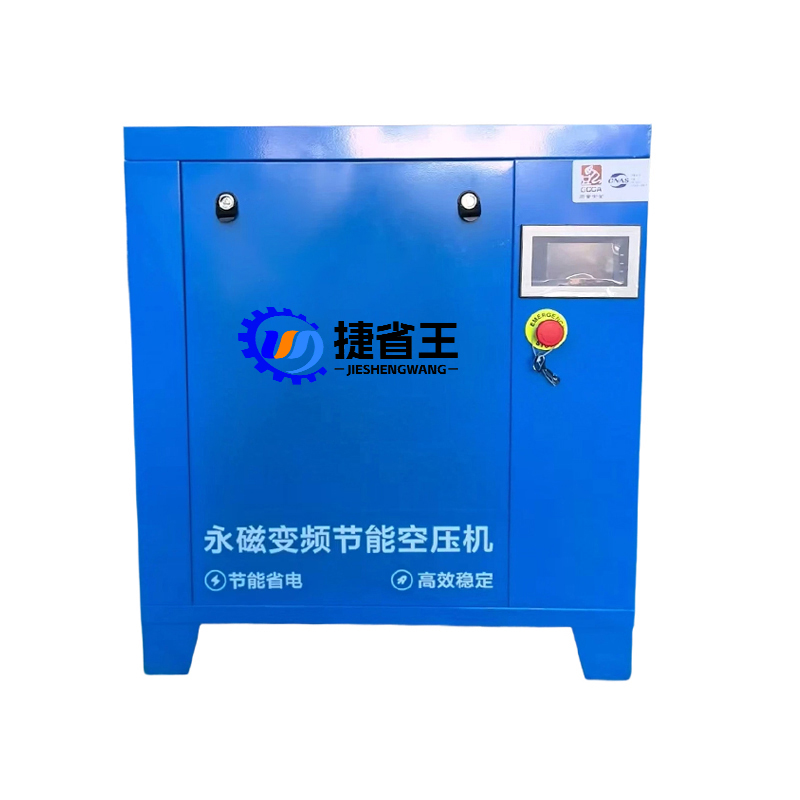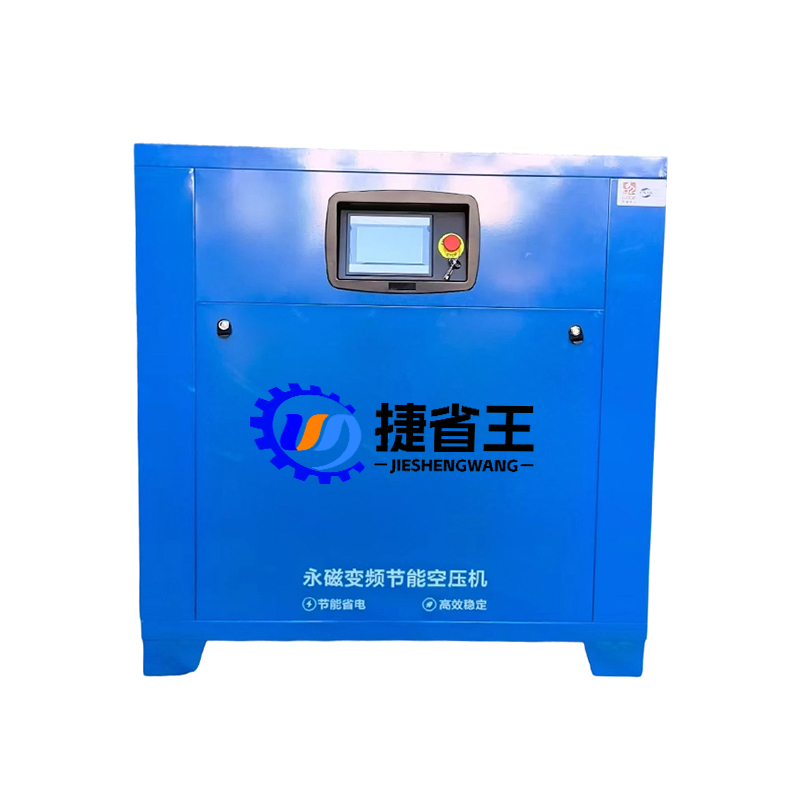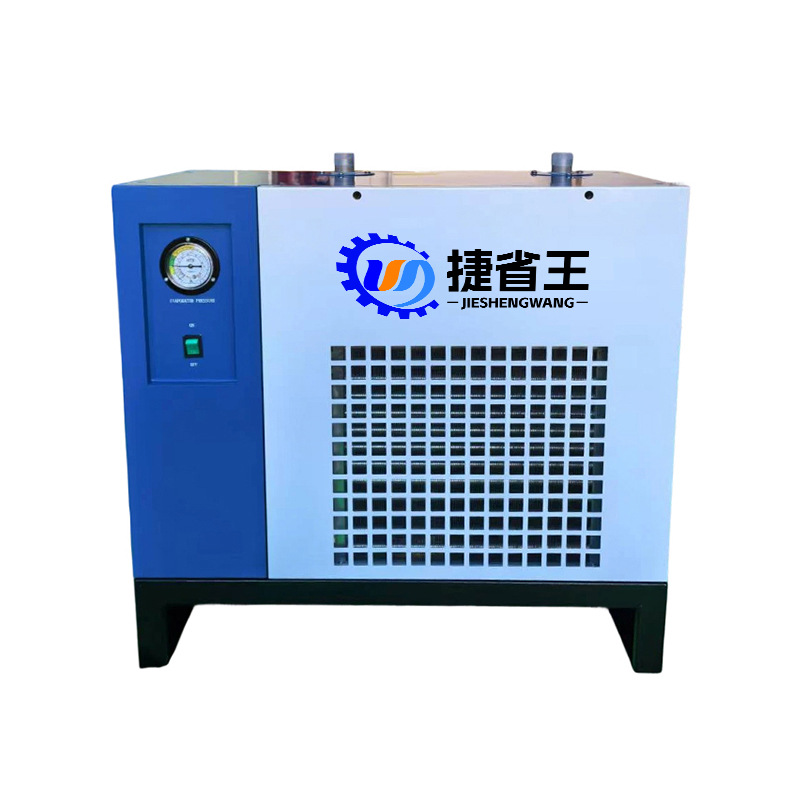How does a permanent magnet variable frequency air compressor achieve dynamic matching of energy consumption and exhaust volume through variable frequency control?
Release Time : 2025-10-27
The permanent magnet variable frequency air compressor uses variable frequency control to dynamically match energy consumption with exhaust volume. Its core approach lies in the in-depth integration of permanent magnet synchronous motors and variable frequency drive technology, creating an adaptively adjustable compressed air supply system. This system uses actual demand from the user as input and uses a variable frequency drive (VFD) to adjust motor speed in real time, ensuring precise alignment between exhaust volume and load, thereby meeting process requirements while minimizing energy consumption.
Traditional air compressors operate in a fixed-frequency mode, with exhaust volume regulated by a load/unload valve. This results in significant energy waste. When air demand falls below the rated value, the fixed-frequency compressor discharges excess compressed air through the unloading valve. This process not only consumes energy to maintain motor operation but also increases mechanical wear due to repeated starts and stops. The permanent magnet variable frequency air compressor, on the other hand, uses a VFD to convert industrial power into adjustable-frequency AC power, driving the permanent magnet synchronous motor for stepless speed control. When air demand decreases, the VFD reduces its output frequency, which in turn reduces motor speed and exhaust volume. Conversely, the VFD increases its speed to increase air supply. This dynamic adjustment mechanism ensures the air compressor always operates within its optimal efficiency range, avoiding energy loss in fixed-frequency mode.
The characteristics of permanent magnet synchronous motors provide the physical basis for dynamic matching. Their rotors use permanent magnets instead of the excitation windings of traditional motors, eliminating losses caused by rotor induced current. Simultaneously, the stator's rotating magnetic field rotates synchronously with the rotor's permanent magnet field, achieving zero-slip operation. This structure enables the motor to maintain high power factor and efficiency across a wide speed range, with the efficiency advantage being particularly significant at low speeds. Compared to traditional asynchronous motors, permanent magnet synchronous motors can achieve efficiency improvements of over 15% at partial load, providing the hardware support for the energy-saving benefits of variable frequency control.
The core of the variable frequency control system is real-time monitoring and rapid response. Using pressure sensors installed at the air consumption end, the system accurately senses changes in compressed air demand and feeds the signal back to the inverter. The inverter's built-in PID control algorithm adjusts the output frequency within milliseconds based on the pressure deviation, driving the motor speed to change synchronously. For example, when a production line's gas consumption suddenly increases, the system increases the motor speed within 0.1 seconds to quickly match the exhaust volume to demand. When gas consumption decreases, the system immediately reduces the speed to avoid energy waste caused by over-compression. This closed-loop control mode ensures precise synchronization of exhaust volume and gas consumption.
The energy-saving effect of dynamic matching is also reflected in improved pressure stability. Traditional air compressors experience large fluctuations in supply pressure due to load/unload adjustments, typically fluctuating within a range of 0.07 MPa above or below the rated pressure. However, the permanent magnet variable frequency air compressor continuously adjusts the speed to control pressure fluctuations within ±0.01 MPa, achieving constant pressure supply. This stable pressure not only improves the operating efficiency of gas-consuming equipment but also reduces compressed air leakage caused by sudden pressure changes, further reducing system energy consumption.
From a mechanical perspective, the permanent magnet variable frequency air compressor's integrated design also optimizes transmission efficiency. The motor and screw main unit are directly connected coaxially, eliminating intermediate transmission components such as belts and couplings, achieving a transmission efficiency close to 100%. This structure eliminates the energy loss caused by transmission component wear in traditional air compressors, while also reducing maintenance frequency and extending equipment life.
In practical applications, the dynamic adaptability of the permanent magnet variable frequency air compressor can meet diverse operating requirements. Whether in automated production lines with frequently fluctuating air usage or backup air supply systems requiring long-term low-load operation, this technology can optimize the balance between energy consumption and air supply by adjusting the speed-displacement curve. Energy savings typically range from 10% to 35%, depending on the degree of fluctuation in air usage patterns and the load factor.






